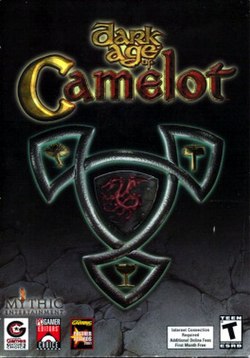Dark Age of Camelot
| Dark Age of Camelot | |
|---|---|

Original cover art
|
|
| Developer(s) |
Mythic Entertainment Broadsword Online Games |
| Publisher(s) |
Vivendi Games (US) Wanadoo (Europe) Electronic Arts (2006-present) |
| Designer(s) |
Mark Jacobs Matt Firor Rob Denton |
| Engine | Gamebryo |
| Platform(s) | Microsoft Windows |
| Release |
|
| Genre(s) | MMORPG |
| Mode(s) | Multiplayer |
| Aggregate scores | |
|---|---|
| Aggregator | Score |
| GameRankings | 88% (24 reviews) |
| Metacritic | 88/100 (18 reviews) |
| Review scores | |
| Publication | Score |
| CGW | |
| Game Informer | 8.5/10 |
| GameSpot | 91/100 |
| GameSpy | 92/100 |
| IGN | 90/100 |
| PC Magazine | |
| Gameplanet | |
Dark Age of Camelot (DAoC) is a 3D medieval fantasy MMORPG, released on October 10, 2001 in North America and in Europe shortly after through its partner GOA. The game combines Arthurian lore, Norse mythology and Irish Celtic legends with a dash of high fantasy. It is set in the period after King Arthur's death and his kingdom has split into three parts which are in a constant state of war with each other. DAoC includes both Player versus Environment (PvE) and Realm versus Realm (RvR) combat.
It was announced on February 5, 2014, that development of the game would be transferred from Mythic Entertainment to a newly made studio (Broadsword Online Games) who will take over all future development of the game. Mythic was subsequently shut down shortly thereafter on May 29, 2014.
The decision to develop Dark Age of Camelot was made in late 1999, with it originally being conceived of as a graphical MUD.Mythic Entertainment president Mark Jacobs proposed the idea of using Arthurian legend since it was on the public domain and thus the company would be free of any licensing issues. Total development costs excluding equipment leases was about $2.5 million and took 18 months with a team of 25 full-time developers.3DS Max and Character Studio were used to create all models and animations within the game.
Toward the end of development, Mythic found themselves in a tough situation as they had never borrowed money before and had no credit rating to lease the Dell servers needed to run the game. After being denied the lease by Dell, Mythic had to purchase each and every server using their development funds. Securing a publisher was also a difficult task; as every publisher that Mythic initially approached rejected the game except for one, Vivendi Games. In 2014, Jacobs still expressed gratitude to Vivendi for taking a chance on the studio.
...
Wikipedia
